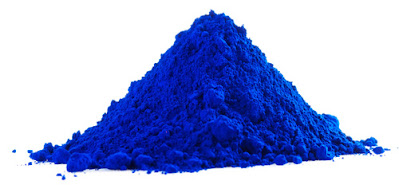Ultramarine Blue Pigment
Ultramarine blue is a vivid and deep blue pigment that has
been used for centuries in art and industry. It is one of the most famous and
widely used blue pigments throughout history. Here's some information about
ultramarine blue pigment:
- Composition: Ultramarine blue pigment is primarily composed of a mineral called lazurite, which is a complex silicate containing sulfur. It also contains small amounts of other minerals such as calcite, sodalite, and hauyne, which can affect the shade and quality of the pigment.
- History: Ultramarine blue has a long history and was first synthesized in ancient times. Initially, it was made from the precious stone lapis lazuli, which had to be ground into a fine powder. The process was laborious and expensive, making ultramarine blue one of the most expensive pigments. It was highly valued by artists, especially in the Renaissance period.
- Synthetic Ultramarine: In the early 19th century, a synthetic version of ultramarine blue was developed, making the pigment more affordable and widely accessible. Synthetic ultramarine blue is chemically similar to the natural version but is manufactured through chemical reactions using materials like kaolin, sulfur, and soda ash.
- Characteristics: Ultramarine blue is known for its intense, vibrant blue color, often described as a deep, rich, or royal blue. It has excellent lightfastness, meaning it resists fading when exposed to light. It is also generally considered non-toxic and is stable under normal conditions.
- Applications: Ultramarine Blue Pigment has been widely used in various applications, including art, paint manufacturing, textiles, cosmetics, and plastics. In art, it has been used by renowned artists such as Michelangelo and Vermeer. In the industry, it is used for coloring products like plastics, ceramics, and rubber.
- Variations: Ultramarine blue can come in different shades, ranging from a warm blue to a cooler blue. Variations include ultramarine blue deep, ultramarine blue green shade, and ultramarine blue red shade, each having slightly different undertones.
It's important to note that while ultramarine blue is generally considered stable and safe, some variations of the pigment may contain trace amounts of impurities. Always follow the manufacturer's instructions and safety guidelines when using any pigment or art material.
Visit at :- https://www.ultramarinebluepigments.com/




Comments
Post a Comment